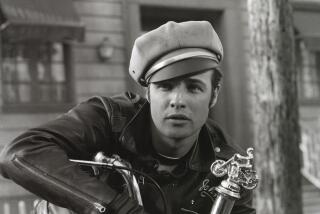Review: ‘The Longest Ride’ looks pretty, but looks aren’t everything
Even with all “The Longest Ride’s” shots of the eye candy that is Scott Eastwood, Nicholas Sparks’ latest romance to make its tissue-sodden way to the big screen is a wash. A long one.
Montages of walks along the ocean, horseback rides through verdant meadows and Eastwood’s ever-present abs do provide endless pretty pictures. (In the looks department, Eastwood definitely does Daddy Clint proud.) But pretty pictures do not make a movie.
The two-plus hours is mostly marked by an emptiness born of scene after scene designed to blatantly manipulate emotions rather than trigger them.
More disquieting is Sparks’ co-opting of the very compelling real-life story of Herb and Dorothy Vogel. The New York couple used Herb’s modest postal worker salary to amass a modern art collection of incredible value. Their achievement, recounted in Megumi Sasaki’s acclaimed 2008 documentary “Herb & Dorothy,” sparked an onslaught of publicity for the unassuming pair, who ultimately gave their entire collection to The National Gallery of Art where the public could see it for free, rather than sell it for millions.
A few details have been changed in both the book and the movie, including their names and their hometown, but the heart of their story becomes the uncredited heart of “The Longest Ride.”
Alan Alda plays 91-year-old Ira Levinson, who spends much of the salary he earns at the family’s haberdashery (Herb’s father was a tailor too) on his wife Ruth’s passion for paintings, amassing a major modern art collection of incredible value.
Director George Tillman Jr., who brought such a lovely restrained touch to the 2013 drama about two young inner city boys surviving a summer on their own in “The Inevitable Defeat of Mister & Pete,” gets swamped by the sentiment that characterizes Sparks’ work. For fans of the book, screenwriter Craig Bolotin makes only minor adjustments. Adding intellect, insight or real romance are not among the changes.
Like “The Notebook,” the Sparks’ film adaptation that remains the best of a bad lot, “The Longest Ride” has two parallel love stories. One revolves around a newly minted couple, the hot, bull-riding, got-to-save-the-family-farm-for-my-widowed-mom Luke Collins (Eastwood), and the smart, grounded, still-recovering-from-a-broken-heart Sophia Danko (Britt Robertson).
Their meet cute comes after Luke’s win at a local bull-riding competition that Sophia’s college classmates have dragged her to — the promise of hot cowboys and line dancing are hard to turn down. Luke’s near-lethal ride a year ago on a fearsome bull named Rango starts playing out in flashbacks, as do so many other pieces of the puzzle. Rango, portrayed with a great deal of bucking brio by a real bull named Rango, is a muscular specimen in his own right, and gets almost as much love from the camera as Luke.
Luke and Sophia’s official first date connects them to Ira when they spot his crashed car, and on closer inspection, discover a badly injured Ira inside. Luke saves the elderly man, pulling him from the burning auto. Sophia saves his precious box of love letters, and the entwining of their lives begins.
Alda, who can be so affecting, is given little to do except spend time in a hospital bed and provide a reason for flashbacks to Ira’s younger days. Most of what we know about him and his beloved Ruth is set in the post-World War II era. They plan to marry, but boot camp and his service delay things. The war injury that leaves Ira unable to give Ruth the big family she wants threatens to end their story. But this is a Nicholas Sparks production, so of course they make it through and begin collecting art instead.
Ruth and Ira’s younger selves are played by Jack Huston, the great John’s grandson, and Oona Chaplin, Charlie’s granddaughter and Eugene O’Neill’s great-granddaughter. It’s unclear between the family tree of Eastwood, Chaplin and Huston who would win the Hollywood A-list legacy battle.
Chaplin and Huston do a slightly better job of steaming up the screen than Eastwood and Robertson. It’s not so much the actors’ fault as those distracting Eastwood abs. I don’t think Huston ever gets a chance to join in the Calvin Klein-esque underwear shoot that is ready to spring into action any time Luke sheds his shirt.
In a nod to Jewish culture and history, we learn Ruth’s desire for family is tied to the loss of hers. Most of her relatives didn’t make it out of Austria once Hitler took control. That reveal comes as she and Ira walk home from a synagogue, moments that look remarkably like typical Southern Sunday go-to meeting scenes except for the “good Shabbats.”
Ira’s love letters, which Sophia keeps stopping by the hospital to read to him, become the key framing device to help Luke and Sophia work through their relationship issues. Both couples have conflicts that test their relationships. In fact, “The Longest Ride” is filled with many moments when it seems all might fall apart. But true to the Sparks’ literary formula, for Ira and Ruth, Luke and Sophia, it all works out in the end — which would only qualify as a spoiler if it didn’t.
-------------------------
“The Longest Ride”
MPAA rating: PG-13 for some sexuality, partial nudity and some war and sports action
Running time: 2 hours, 19 minutes
Playing: In general release
More to Read
Only good movies
Get the Indie Focus newsletter, Mark Olsen's weekly guide to the world of cinema.
You may occasionally receive promotional content from the Los Angeles Times.







